Analyzing Organizational Behavior: HY Dairies Ltd Case Study
VerifiedAdded on 2022/08/15
|8
|1696
|42
Case Study
AI Summary
This case study examines the organizational behavior at HY Dairies Ltd, focusing on the situation of Brand Manager Rochelle Beauport. The analysis identifies symptoms of workplace discrimination based on gender and race. The case explores the decisions made by Vice President Gilman, who offered Beauport a marketing position but later transferred her to a technical support role. Beauport perceives this as a demotion and a result of discrimination, referencing previous experiences and societal biases. The study discusses social identity theory and its role in explaining biases within the work environment. It also analyzes how the organization's actions and Gilman's perspectives differ from Beauport's, highlighting the impact of these actions on her motivation and confidence. The paper concludes with suggestions for the organization to address these issues, including considering employee feedback and avoiding discriminatory practices. The case references various academic sources to support its arguments and findings, providing a comprehensive analysis of the situation and potential solutions.
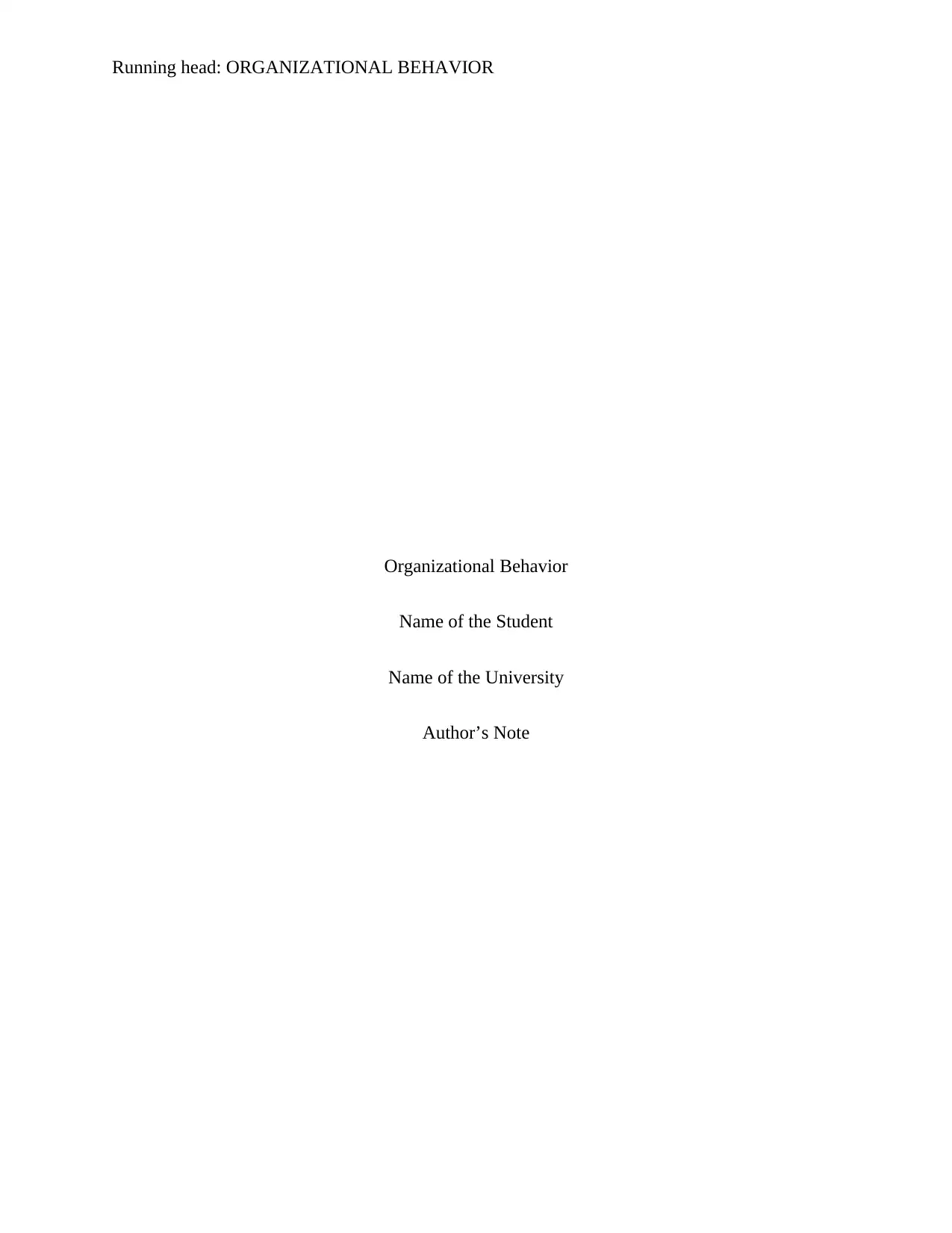
Running head: ORGANIZATIONAL BEHAVIOR
Organizational Behavior
Name of the Student
Name of the University
Author’s Note
Organizational Behavior
Name of the Student
Name of the University
Author’s Note
Paraphrase This Document
Need a fresh take? Get an instant paraphrase of this document with our AI Paraphraser
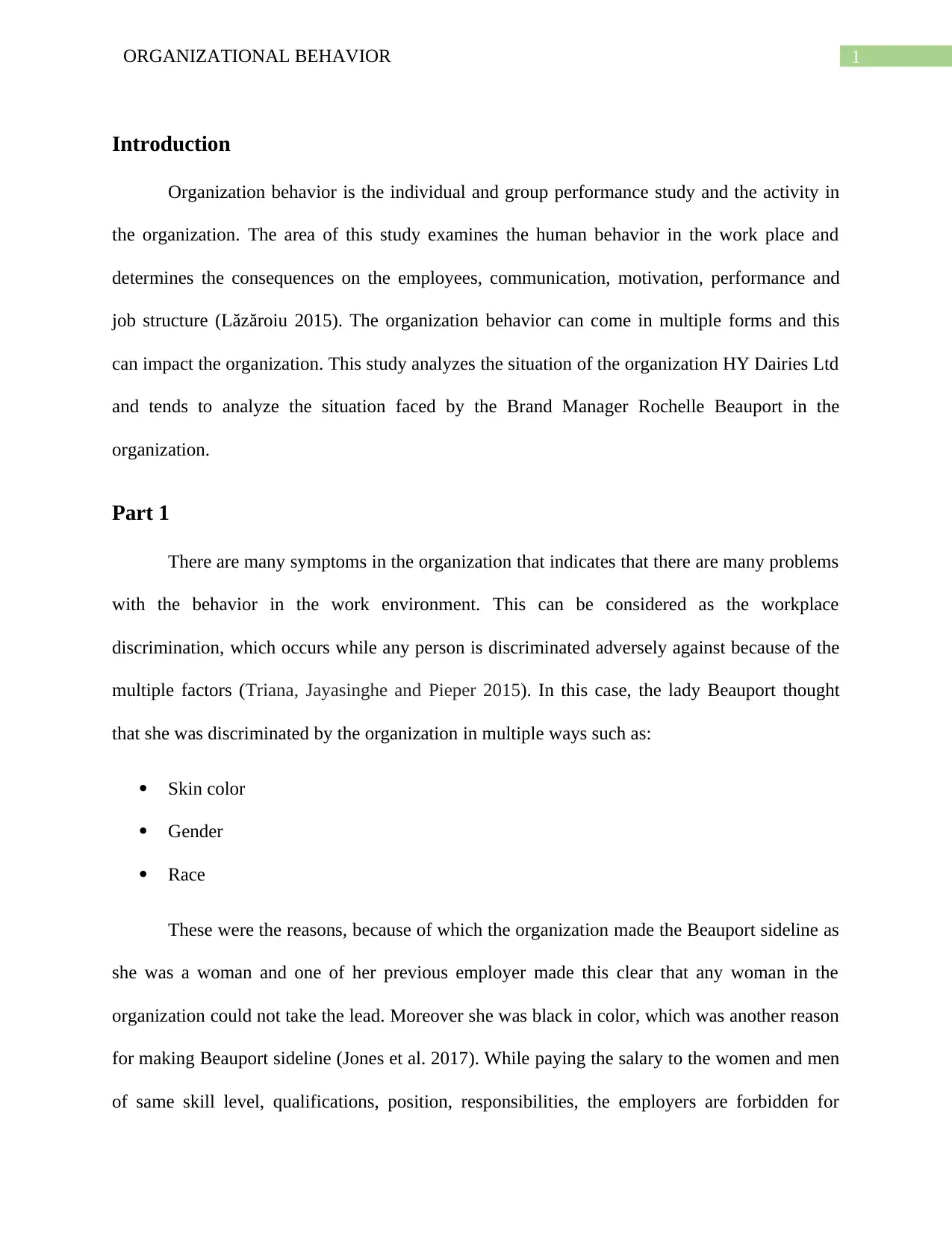
1ORGANIZATIONAL BEHAVIOR
Introduction
Organization behavior is the individual and group performance study and the activity in
the organization. The area of this study examines the human behavior in the work place and
determines the consequences on the employees, communication, motivation, performance and
job structure (Lăzăroiu 2015). The organization behavior can come in multiple forms and this
can impact the organization. This study analyzes the situation of the organization HY Dairies Ltd
and tends to analyze the situation faced by the Brand Manager Rochelle Beauport in the
organization.
Part 1
There are many symptoms in the organization that indicates that there are many problems
with the behavior in the work environment. This can be considered as the workplace
discrimination, which occurs while any person is discriminated adversely against because of the
multiple factors (Triana, Jayasinghe and Pieper 2015). In this case, the lady Beauport thought
that she was discriminated by the organization in multiple ways such as:
Skin color
Gender
Race
These were the reasons, because of which the organization made the Beauport sideline as
she was a woman and one of her previous employer made this clear that any woman in the
organization could not take the lead. Moreover she was black in color, which was another reason
for making Beauport sideline (Jones et al. 2017). While paying the salary to the women and men
of same skill level, qualifications, position, responsibilities, the employers are forbidden for
Introduction
Organization behavior is the individual and group performance study and the activity in
the organization. The area of this study examines the human behavior in the work place and
determines the consequences on the employees, communication, motivation, performance and
job structure (Lăzăroiu 2015). The organization behavior can come in multiple forms and this
can impact the organization. This study analyzes the situation of the organization HY Dairies Ltd
and tends to analyze the situation faced by the Brand Manager Rochelle Beauport in the
organization.
Part 1
There are many symptoms in the organization that indicates that there are many problems
with the behavior in the work environment. This can be considered as the workplace
discrimination, which occurs while any person is discriminated adversely against because of the
multiple factors (Triana, Jayasinghe and Pieper 2015). In this case, the lady Beauport thought
that she was discriminated by the organization in multiple ways such as:
Skin color
Gender
Race
These were the reasons, because of which the organization made the Beauport sideline as
she was a woman and one of her previous employer made this clear that any woman in the
organization could not take the lead. Moreover she was black in color, which was another reason
for making Beauport sideline (Jones et al. 2017). While paying the salary to the women and men
of same skill level, qualifications, position, responsibilities, the employers are forbidden for
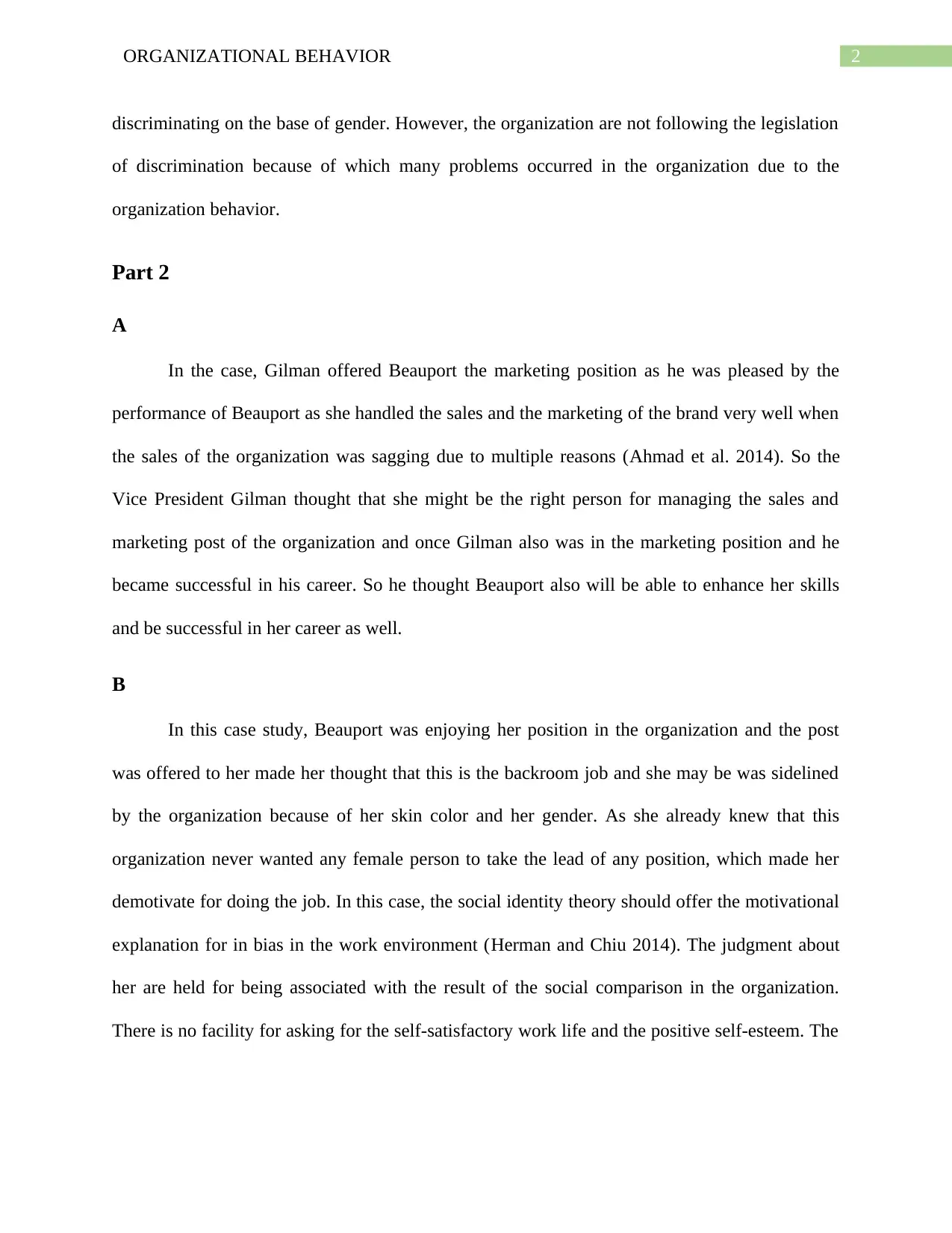
2ORGANIZATIONAL BEHAVIOR
discriminating on the base of gender. However, the organization are not following the legislation
of discrimination because of which many problems occurred in the organization due to the
organization behavior.
Part 2
A
In the case, Gilman offered Beauport the marketing position as he was pleased by the
performance of Beauport as she handled the sales and the marketing of the brand very well when
the sales of the organization was sagging due to multiple reasons (Ahmad et al. 2014). So the
Vice President Gilman thought that she might be the right person for managing the sales and
marketing post of the organization and once Gilman also was in the marketing position and he
became successful in his career. So he thought Beauport also will be able to enhance her skills
and be successful in her career as well.
B
In this case study, Beauport was enjoying her position in the organization and the post
was offered to her made her thought that this is the backroom job and she may be was sidelined
by the organization because of her skin color and her gender. As she already knew that this
organization never wanted any female person to take the lead of any position, which made her
demotivate for doing the job. In this case, the social identity theory should offer the motivational
explanation for in bias in the work environment (Herman and Chiu 2014). The judgment about
her are held for being associated with the result of the social comparison in the organization.
There is no facility for asking for the self-satisfactory work life and the positive self-esteem. The
discriminating on the base of gender. However, the organization are not following the legislation
of discrimination because of which many problems occurred in the organization due to the
organization behavior.
Part 2
A
In the case, Gilman offered Beauport the marketing position as he was pleased by the
performance of Beauport as she handled the sales and the marketing of the brand very well when
the sales of the organization was sagging due to multiple reasons (Ahmad et al. 2014). So the
Vice President Gilman thought that she might be the right person for managing the sales and
marketing post of the organization and once Gilman also was in the marketing position and he
became successful in his career. So he thought Beauport also will be able to enhance her skills
and be successful in her career as well.
B
In this case study, Beauport was enjoying her position in the organization and the post
was offered to her made her thought that this is the backroom job and she may be was sidelined
by the organization because of her skin color and her gender. As she already knew that this
organization never wanted any female person to take the lead of any position, which made her
demotivate for doing the job. In this case, the social identity theory should offer the motivational
explanation for in bias in the work environment (Herman and Chiu 2014). The judgment about
her are held for being associated with the result of the social comparison in the organization.
There is no facility for asking for the self-satisfactory work life and the positive self-esteem. The
⊘ This is a preview!⊘
Do you want full access?
Subscribe today to unlock all pages.

Trusted by 1+ million students worldwide
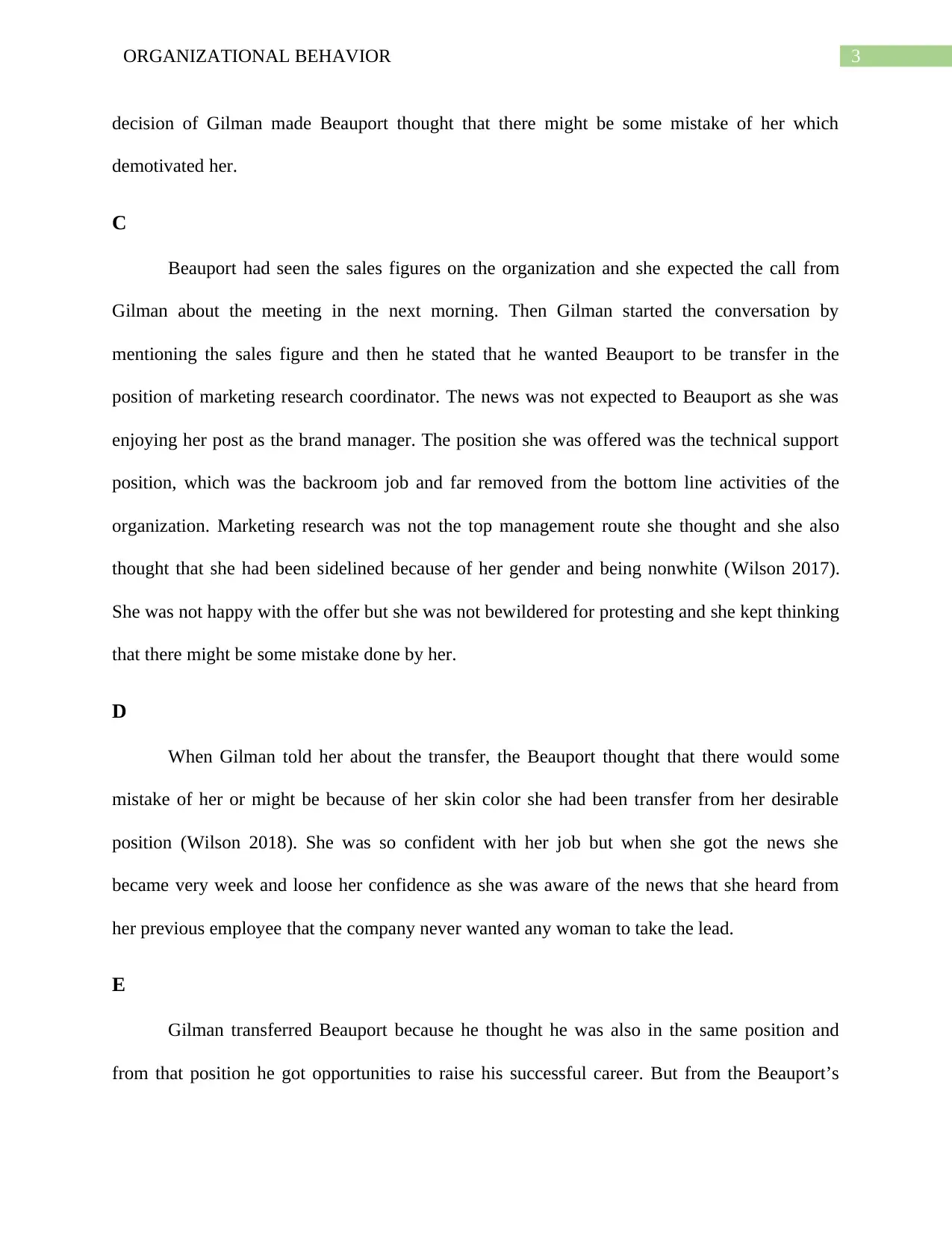
3ORGANIZATIONAL BEHAVIOR
decision of Gilman made Beauport thought that there might be some mistake of her which
demotivated her.
C
Beauport had seen the sales figures on the organization and she expected the call from
Gilman about the meeting in the next morning. Then Gilman started the conversation by
mentioning the sales figure and then he stated that he wanted Beauport to be transfer in the
position of marketing research coordinator. The news was not expected to Beauport as she was
enjoying her post as the brand manager. The position she was offered was the technical support
position, which was the backroom job and far removed from the bottom line activities of the
organization. Marketing research was not the top management route she thought and she also
thought that she had been sidelined because of her gender and being nonwhite (Wilson 2017).
She was not happy with the offer but she was not bewildered for protesting and she kept thinking
that there might be some mistake done by her.
D
When Gilman told her about the transfer, the Beauport thought that there would some
mistake of her or might be because of her skin color she had been transfer from her desirable
position (Wilson 2018). She was so confident with her job but when she got the news she
became very week and loose her confidence as she was aware of the news that she heard from
her previous employee that the company never wanted any woman to take the lead.
E
Gilman transferred Beauport because he thought he was also in the same position and
from that position he got opportunities to raise his successful career. But from the Beauport’s
decision of Gilman made Beauport thought that there might be some mistake of her which
demotivated her.
C
Beauport had seen the sales figures on the organization and she expected the call from
Gilman about the meeting in the next morning. Then Gilman started the conversation by
mentioning the sales figure and then he stated that he wanted Beauport to be transfer in the
position of marketing research coordinator. The news was not expected to Beauport as she was
enjoying her post as the brand manager. The position she was offered was the technical support
position, which was the backroom job and far removed from the bottom line activities of the
organization. Marketing research was not the top management route she thought and she also
thought that she had been sidelined because of her gender and being nonwhite (Wilson 2017).
She was not happy with the offer but she was not bewildered for protesting and she kept thinking
that there might be some mistake done by her.
D
When Gilman told her about the transfer, the Beauport thought that there would some
mistake of her or might be because of her skin color she had been transfer from her desirable
position (Wilson 2018). She was so confident with her job but when she got the news she
became very week and loose her confidence as she was aware of the news that she heard from
her previous employee that the company never wanted any woman to take the lead.
E
Gilman transferred Beauport because he thought he was also in the same position and
from that position he got opportunities to raise his successful career. But from the Beauport’s
Paraphrase This Document
Need a fresh take? Get an instant paraphrase of this document with our AI Paraphraser
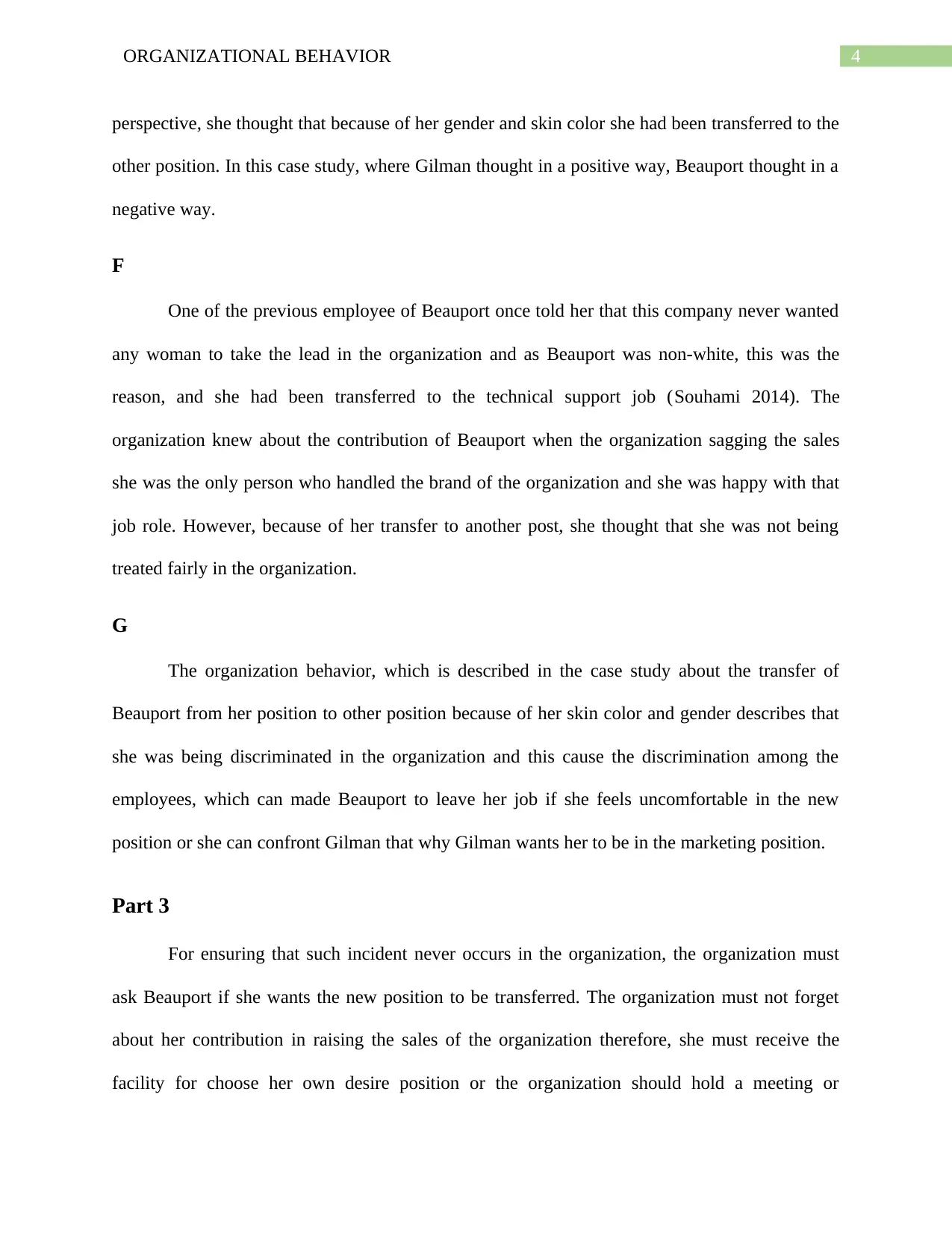
4ORGANIZATIONAL BEHAVIOR
perspective, she thought that because of her gender and skin color she had been transferred to the
other position. In this case study, where Gilman thought in a positive way, Beauport thought in a
negative way.
F
One of the previous employee of Beauport once told her that this company never wanted
any woman to take the lead in the organization and as Beauport was non-white, this was the
reason, and she had been transferred to the technical support job (Souhami 2014). The
organization knew about the contribution of Beauport when the organization sagging the sales
she was the only person who handled the brand of the organization and she was happy with that
job role. However, because of her transfer to another post, she thought that she was not being
treated fairly in the organization.
G
The organization behavior, which is described in the case study about the transfer of
Beauport from her position to other position because of her skin color and gender describes that
she was being discriminated in the organization and this cause the discrimination among the
employees, which can made Beauport to leave her job if she feels uncomfortable in the new
position or she can confront Gilman that why Gilman wants her to be in the marketing position.
Part 3
For ensuring that such incident never occurs in the organization, the organization must
ask Beauport if she wants the new position to be transferred. The organization must not forget
about her contribution in raising the sales of the organization therefore, she must receive the
facility for choose her own desire position or the organization should hold a meeting or
perspective, she thought that because of her gender and skin color she had been transferred to the
other position. In this case study, where Gilman thought in a positive way, Beauport thought in a
negative way.
F
One of the previous employee of Beauport once told her that this company never wanted
any woman to take the lead in the organization and as Beauport was non-white, this was the
reason, and she had been transferred to the technical support job (Souhami 2014). The
organization knew about the contribution of Beauport when the organization sagging the sales
she was the only person who handled the brand of the organization and she was happy with that
job role. However, because of her transfer to another post, she thought that she was not being
treated fairly in the organization.
G
The organization behavior, which is described in the case study about the transfer of
Beauport from her position to other position because of her skin color and gender describes that
she was being discriminated in the organization and this cause the discrimination among the
employees, which can made Beauport to leave her job if she feels uncomfortable in the new
position or she can confront Gilman that why Gilman wants her to be in the marketing position.
Part 3
For ensuring that such incident never occurs in the organization, the organization must
ask Beauport if she wants the new position to be transferred. The organization must not forget
about her contribution in raising the sales of the organization therefore, she must receive the
facility for choose her own desire position or the organization should hold a meeting or
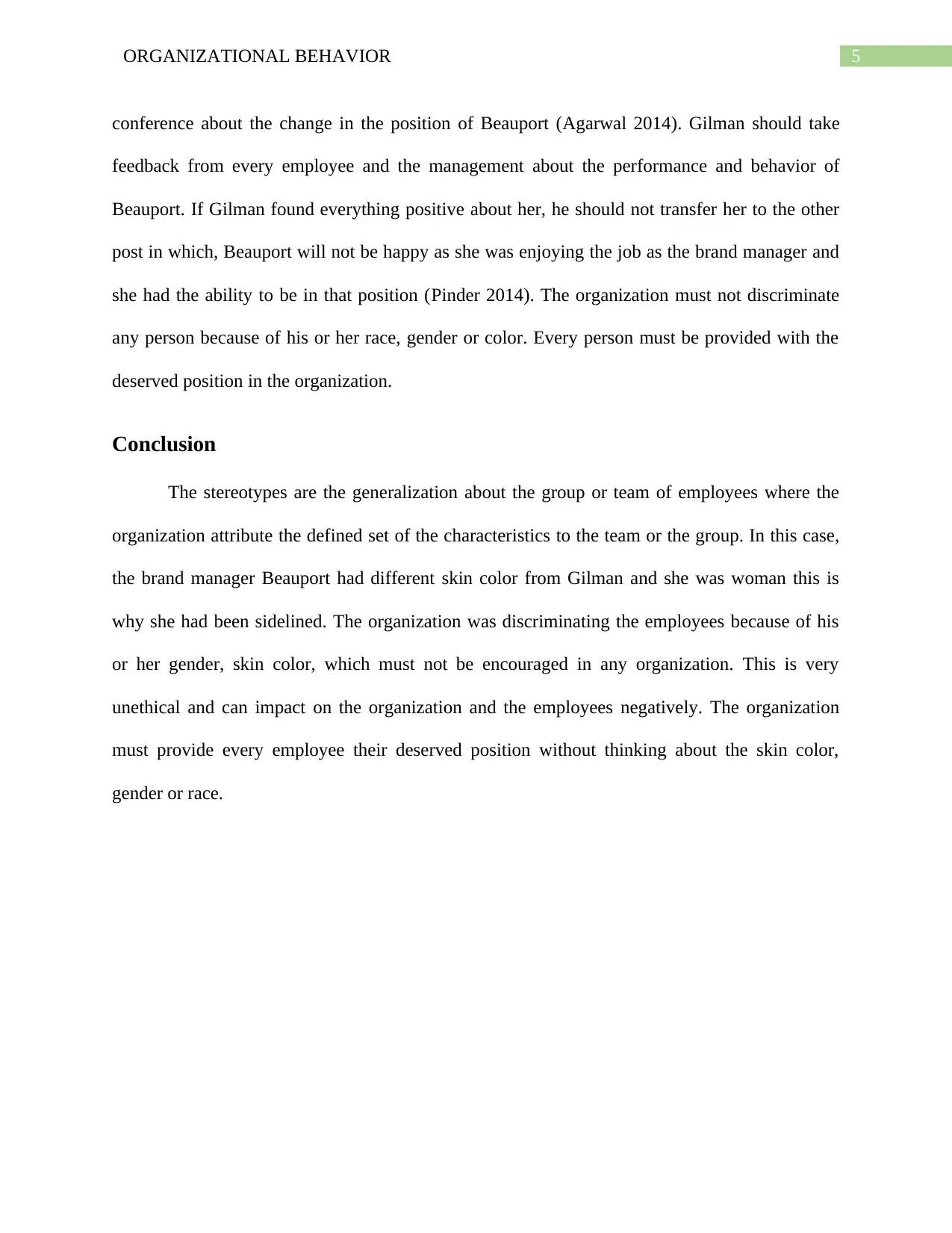
5ORGANIZATIONAL BEHAVIOR
conference about the change in the position of Beauport (Agarwal 2014). Gilman should take
feedback from every employee and the management about the performance and behavior of
Beauport. If Gilman found everything positive about her, he should not transfer her to the other
post in which, Beauport will not be happy as she was enjoying the job as the brand manager and
she had the ability to be in that position (Pinder 2014). The organization must not discriminate
any person because of his or her race, gender or color. Every person must be provided with the
deserved position in the organization.
Conclusion
The stereotypes are the generalization about the group or team of employees where the
organization attribute the defined set of the characteristics to the team or the group. In this case,
the brand manager Beauport had different skin color from Gilman and she was woman this is
why she had been sidelined. The organization was discriminating the employees because of his
or her gender, skin color, which must not be encouraged in any organization. This is very
unethical and can impact on the organization and the employees negatively. The organization
must provide every employee their deserved position without thinking about the skin color,
gender or race.
conference about the change in the position of Beauport (Agarwal 2014). Gilman should take
feedback from every employee and the management about the performance and behavior of
Beauport. If Gilman found everything positive about her, he should not transfer her to the other
post in which, Beauport will not be happy as she was enjoying the job as the brand manager and
she had the ability to be in that position (Pinder 2014). The organization must not discriminate
any person because of his or her race, gender or color. Every person must be provided with the
deserved position in the organization.
Conclusion
The stereotypes are the generalization about the group or team of employees where the
organization attribute the defined set of the characteristics to the team or the group. In this case,
the brand manager Beauport had different skin color from Gilman and she was woman this is
why she had been sidelined. The organization was discriminating the employees because of his
or her gender, skin color, which must not be encouraged in any organization. This is very
unethical and can impact on the organization and the employees negatively. The organization
must provide every employee their deserved position without thinking about the skin color,
gender or race.
⊘ This is a preview!⊘
Do you want full access?
Subscribe today to unlock all pages.

Trusted by 1+ million students worldwide
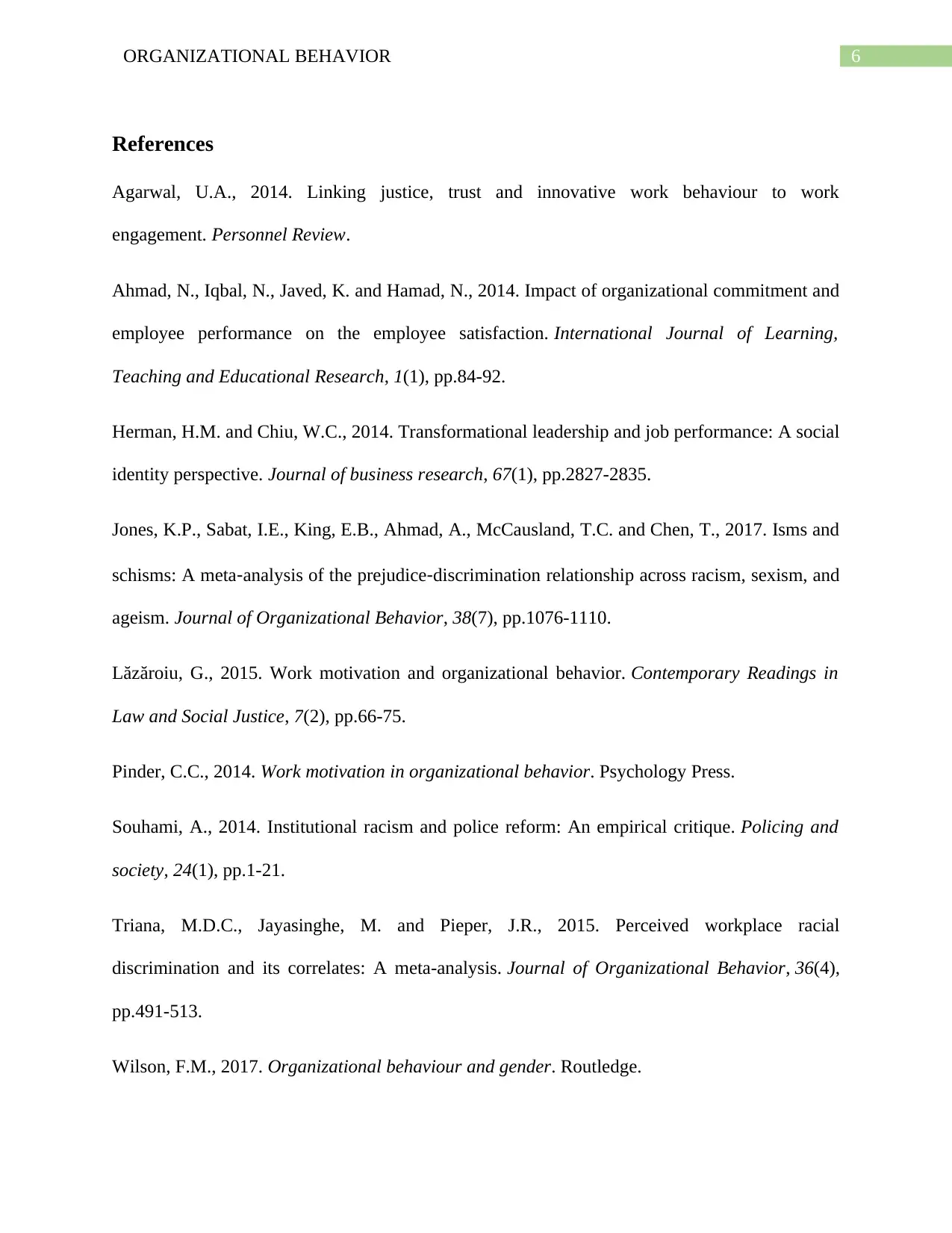
6ORGANIZATIONAL BEHAVIOR
References
Agarwal, U.A., 2014. Linking justice, trust and innovative work behaviour to work
engagement. Personnel Review.
Ahmad, N., Iqbal, N., Javed, K. and Hamad, N., 2014. Impact of organizational commitment and
employee performance on the employee satisfaction. International Journal of Learning,
Teaching and Educational Research, 1(1), pp.84-92.
Herman, H.M. and Chiu, W.C., 2014. Transformational leadership and job performance: A social
identity perspective. Journal of business research, 67(1), pp.2827-2835.
Jones, K.P., Sabat, I.E., King, E.B., Ahmad, A., McCausland, T.C. and Chen, T., 2017. Isms and
schisms: A meta‐analysis of the prejudice‐discrimination relationship across racism, sexism, and
ageism. Journal of Organizational Behavior, 38(7), pp.1076-1110.
Lăzăroiu, G., 2015. Work motivation and organizational behavior. Contemporary Readings in
Law and Social Justice, 7(2), pp.66-75.
Pinder, C.C., 2014. Work motivation in organizational behavior. Psychology Press.
Souhami, A., 2014. Institutional racism and police reform: An empirical critique. Policing and
society, 24(1), pp.1-21.
Triana, M.D.C., Jayasinghe, M. and Pieper, J.R., 2015. Perceived workplace racial
discrimination and its correlates: A meta‐analysis. Journal of Organizational Behavior, 36(4),
pp.491-513.
Wilson, F.M., 2017. Organizational behaviour and gender. Routledge.
References
Agarwal, U.A., 2014. Linking justice, trust and innovative work behaviour to work
engagement. Personnel Review.
Ahmad, N., Iqbal, N., Javed, K. and Hamad, N., 2014. Impact of organizational commitment and
employee performance on the employee satisfaction. International Journal of Learning,
Teaching and Educational Research, 1(1), pp.84-92.
Herman, H.M. and Chiu, W.C., 2014. Transformational leadership and job performance: A social
identity perspective. Journal of business research, 67(1), pp.2827-2835.
Jones, K.P., Sabat, I.E., King, E.B., Ahmad, A., McCausland, T.C. and Chen, T., 2017. Isms and
schisms: A meta‐analysis of the prejudice‐discrimination relationship across racism, sexism, and
ageism. Journal of Organizational Behavior, 38(7), pp.1076-1110.
Lăzăroiu, G., 2015. Work motivation and organizational behavior. Contemporary Readings in
Law and Social Justice, 7(2), pp.66-75.
Pinder, C.C., 2014. Work motivation in organizational behavior. Psychology Press.
Souhami, A., 2014. Institutional racism and police reform: An empirical critique. Policing and
society, 24(1), pp.1-21.
Triana, M.D.C., Jayasinghe, M. and Pieper, J.R., 2015. Perceived workplace racial
discrimination and its correlates: A meta‐analysis. Journal of Organizational Behavior, 36(4),
pp.491-513.
Wilson, F.M., 2017. Organizational behaviour and gender. Routledge.
Paraphrase This Document
Need a fresh take? Get an instant paraphrase of this document with our AI Paraphraser
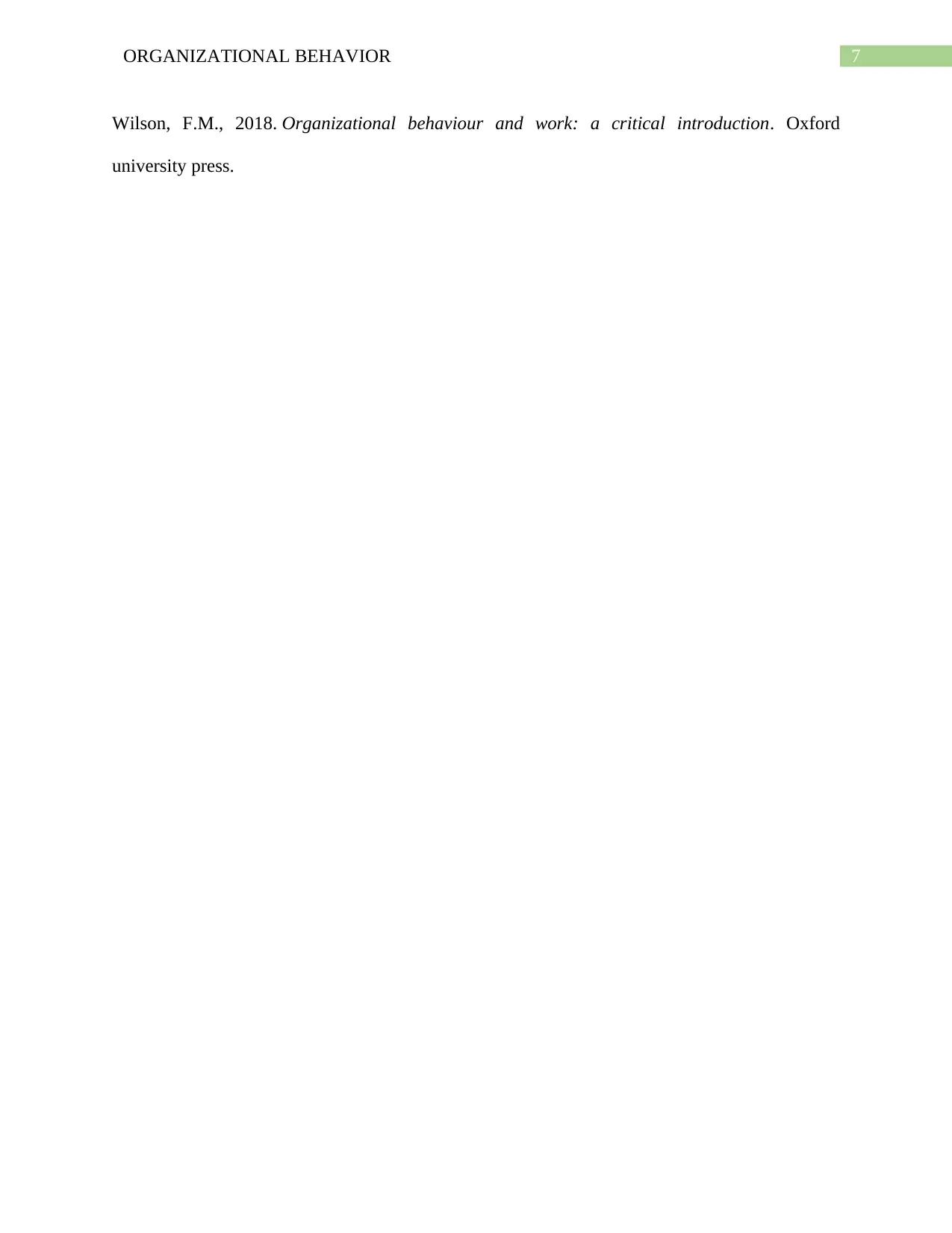
7ORGANIZATIONAL BEHAVIOR
Wilson, F.M., 2018. Organizational behaviour and work: a critical introduction. Oxford
university press.
Wilson, F.M., 2018. Organizational behaviour and work: a critical introduction. Oxford
university press.
1 out of 8
Related Documents
Your All-in-One AI-Powered Toolkit for Academic Success.
+13062052269
info@desklib.com
Available 24*7 on WhatsApp / Email
![[object Object]](/_next/static/media/star-bottom.7253800d.svg)
Unlock your academic potential
Copyright © 2020–2025 A2Z Services. All Rights Reserved. Developed and managed by ZUCOL.





